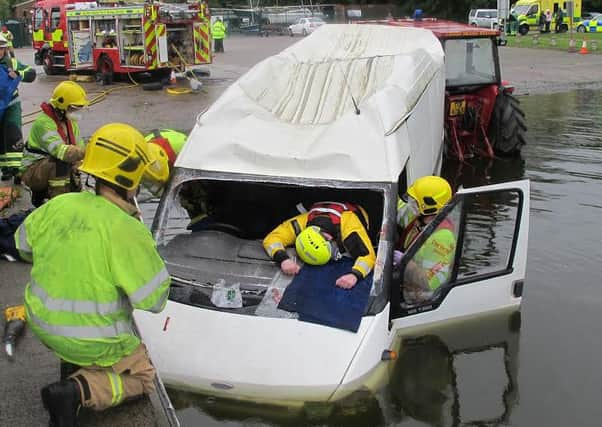LNR join emergency services to test skills in simulated rescue from submerged vehicles


Crew from the rescue service’s three stations joined Northern Ireland Fire & Rescue Service, the PSNI, Northern Ireland Ambulance Service, Sky Watch Civil Air Patrol, the Coastguard and Red Cross as they ‘rescued’ a total of 27 casualties from two vehicles submerged in Lough Neagh.
The Water Babies simulation, which was led by NIFRS, gave the voluntary crew a chance to work beside all professional emergency services at the same time, while gaining invaluable skills according to training manager, Andrew Nicholl.
Advertisement
Hide AdAdvertisement
Hide AdA spokesperson for NIFRS said the large scale emergency training exercise, was organised to test its operational ability to respond to a major RTC and subsequent water rescue resulting from the incident, while enhancing working relations between partner agencies.


The Fire Service also aimed to emphasise contingency arrangements for this type of emergency.
The exercise simulated two vehicles colliding, breaking through a road barrier and ending up in the River Bann, which led to one vehicle being washed away in its fast flowing water.
A minibus was partially submerged on the slip way at Kinnego Marina, with four casualties trapped inside - for the purpose of the rescue one had hit their head on the windscreen, becoming unconscious.
Advertisement
Hide AdAdvertisement
Hide AdAt the second simulation at Oxford Island a family car was half submerged in the lough. It contained three adults and one child, while a second child was trapped under the rear of the car.


At the end of exercise debrief, the 70-strong emergency response team were told they made a total of 27 rescues from the water, although seven were said to be fatalities.
NIFRS Southern Area District Commander Victor Spence said: “Firefighters, as first responders to road traffic collisions see at first hand the devastation caused on our roads. In what is an already harrowing incident, to have the possibility of a subsequent water rescue added certainly tests all of the resources at our disposal.
“This simulated incident enabled us to test numerous operational policies and procedures in relation to our major incident plan. It also allowed us to test inter operability between partner agencies within the area and enhanced our capability in protecting our community.
Advertisement
Hide AdAdvertisement
Hide Ad“We are well prepared and well-rehearsed in readiness for these types of incidents, nonetheless this exercise was extremely valuable and there are learning points for all the agencies involved.


“I would like to thank Kinnego Marina, Oxford Island, Police Service of Northern Ireland, Northern Ireland Ambulance Service, Lough Neagh Rescue and Sky Watch Civil Air Patrol for their co-operation and assistance in making the scenario as real as possible.”
A spokesperson for Lough Neagh Rescue, which retrieved casualties found far from the shoreline, said: “Lough Neagh Rescue was delighted to take part as it was an ideal opportunity to refresh and test our skills in a multi-agency exercise.
“LNR has previously worked with emergency services on smaller scale incidents and simulations, but this realistic and well organised practice operation gave crew from all three of our stations the chance to work alongside professional emergency services - whilst building on our skills.”
‘Well prepared for water rescue’
Advertisement
Hide AdAdvertisement
Hide Ad

While “well prepared and well-rehearsed for these types of incidents” NIFRS said such operations are “extremely valuable” as they throw up “learning points for all the agencies involved”.
PSNI Constable Colin Moore said: “This is about partnership. We can achieve more when working together than we ever could going it alone.”
And Sky Watch Chief Pilot Paul Trimble added: “When the various teams work together we are able to leverage each other strengths. Regular training helps all of us to be prepared for incidents as they happen.”
Over 70 crew from all six agencies took part in the exercise.